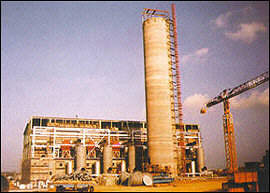 ENERGY: POWER CUTS VS. POWER PROVISION ENERGY: POWER CUTS VS. POWER PROVISION |
Interconnectivity among the East African Community will be further extended once the Kenya Pipeline will reach Uganda. Kenya does not produce any oil, so it strongly relies on imports for internal energy consumption. Most of the country imported oil enters through Kenya Petroleum Refineries, the only refinery specialized in processing white oil products, bitumen, grease, etc. This Company started in 1963 as a joint venture between BP and Shell. After independence a 50% stake was offered to the Government, who has kept it until today. Despite of the ongoing process of privatization there does not seem to be any short term plan to sell. The rest of the shares still belong to Shell-BP, and the remaining 16% to Caltex. Mr. Chris House, General Manager coments that they process according to the demand of the market, but they also have to take into account the needs of the rest of Region. Kenya's oil market was liberalized in 1994 and ever since they have suffered competition from refined oils coming from the Middle East. For the past 2,5 years Kenya Petroleum Refineries had to increase its efficiency and reliablility. Nonetheless production has gone down to 55% of its total capacity (25 million barrels). It is understandable they are looking forward to the start of operations of the two new energy plants the government is planning to complete by the year 2001, since they will be able absorb most of their production.
Until 1996 no major new energy projects had been implemented. Due to the population growth, supply stopped matching demand. In fact, around 80% of Kenya's domestic energy needs are provided for in the form of wood or charcoal. 70% of the total of energy demand is satisfied with wood fuel. Obviously this has a dramatic impact on the environment. Consequently, the Ministry of Energy, decided to take urgent measures in order to alleviate the shortage. The first one was to allow for Independent Power Producers (IPPs) to start production. So far, these IPPs have managed to combinedly generate 88 Mw. However this is still insufficient. Currently Kenya produces 870 Mw of power, but the country is still short of 550 Mw. The previous Minister of Energy, Hon. Chris Okeno (present Minister of Finance) estimates that with the current projects already set in place, Kenya's energetic needs should be covered by the year 2002. By the year 2004, the projected 550 Mw should already be generated, which added to the present 870 Mw, will total 1420 Mw, enough to even export energy. The projects are quite ambitious and they mean to spread and diversify the production of energy in order not to uniquely rely on oil or hydroelectricity. There are 7 major projects under way:
Kipevu I Thermal 75 Mw
Gitaru Hydro 72.5 Mw
Two fast track IPPs 110 Mw (55 Mw each IPP)
Kipevu II 75 Mw (IPP)
Olkaria III Geothermal 64
Mw (IPP)
| Olkaria II 64 Mw
Sondo Miriu Hydro 60 Mw
Out of these, Kipevu I and II should be on stream by 1999-2000. In the long run, explains, Hon. Okeno, they could start exporting to Uganda and Tanzania.
 KENGEN: THE NEW GENERATION OF POWER GENERATORS KENGEN: THE NEW GENERATION OF POWER GENERATORS |

Most of these projects will be executed by KenGen, the recently formed energy generating company in Kenya. Following their split from Kenya Power & Lighting in 1997 they have been in charge of the production of energy, whereas KPLC is in charge of distribution. KenGen today creates 90% of the country's energy capacity. Mr. Edwin Wasunna, Managing Director of KenGen, explains that there are about 5 projects being undertaken countrywide. KenGen has undertaken the construction of a 75 MW diesel Thermal plant near Mombasa (Kipevu), a 60 MW hydro plant in Western Kenya (Sondu Miriu), and a 64 MW geothermal plant at Olkaria, in central Kenya (Naivasha). The remaining 2 have been offered to IPPs: a 75 MW diesel thermal station, and a 64 MW geothermal power station.
Mr. Wasunna is not afraid of new competitors entering the market. So far, he says, "our hands are full. These three projects are stretching our financial resources". These have nevertheless been partly funded by multilateral and bilateral agencies. "We hope that after executing these projects, and depending on our performance 2-3 years from now, we should be able to demonstrate and win confidence of investors". Indeed, KenGen has one of the best-trained work forces in Kenya, and they try to use the latest technology in the power generation and control. Not only that, they claim to be quite environmentally friendly. They even have one complete unit of environmental scientists in their organization.
When asked about renewable sources of energy, Mr. Wasunna mentions that they have 2 units of wind generators in Northern Kenya, in the border with Kenya, where winds are good and constant. But for the time being they are looking at more cost-effective resources such as geothermal energy or hydroelectricity. |

